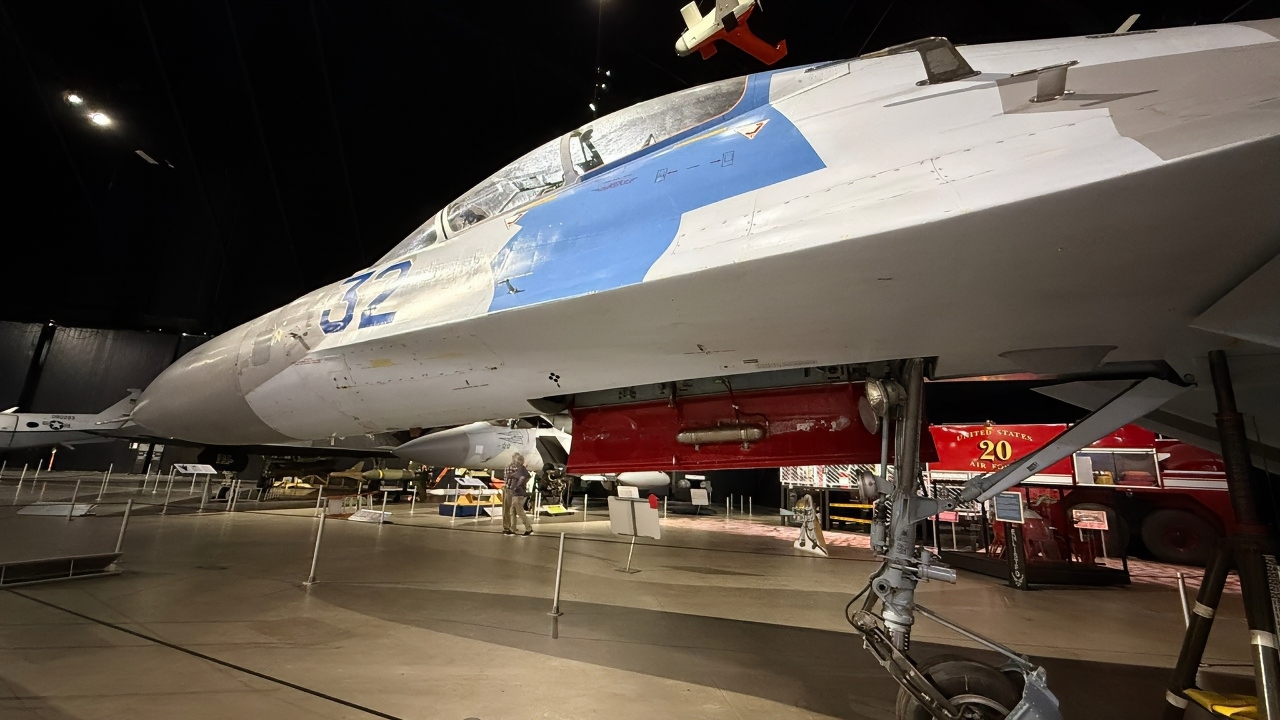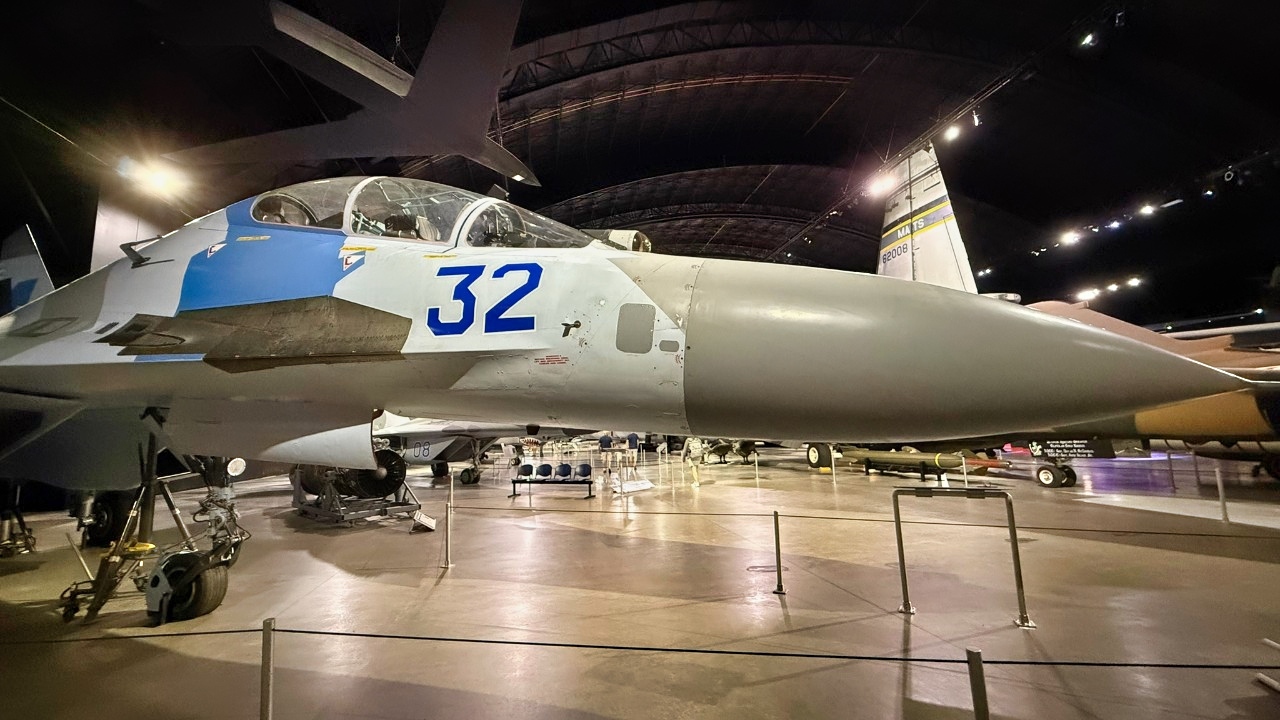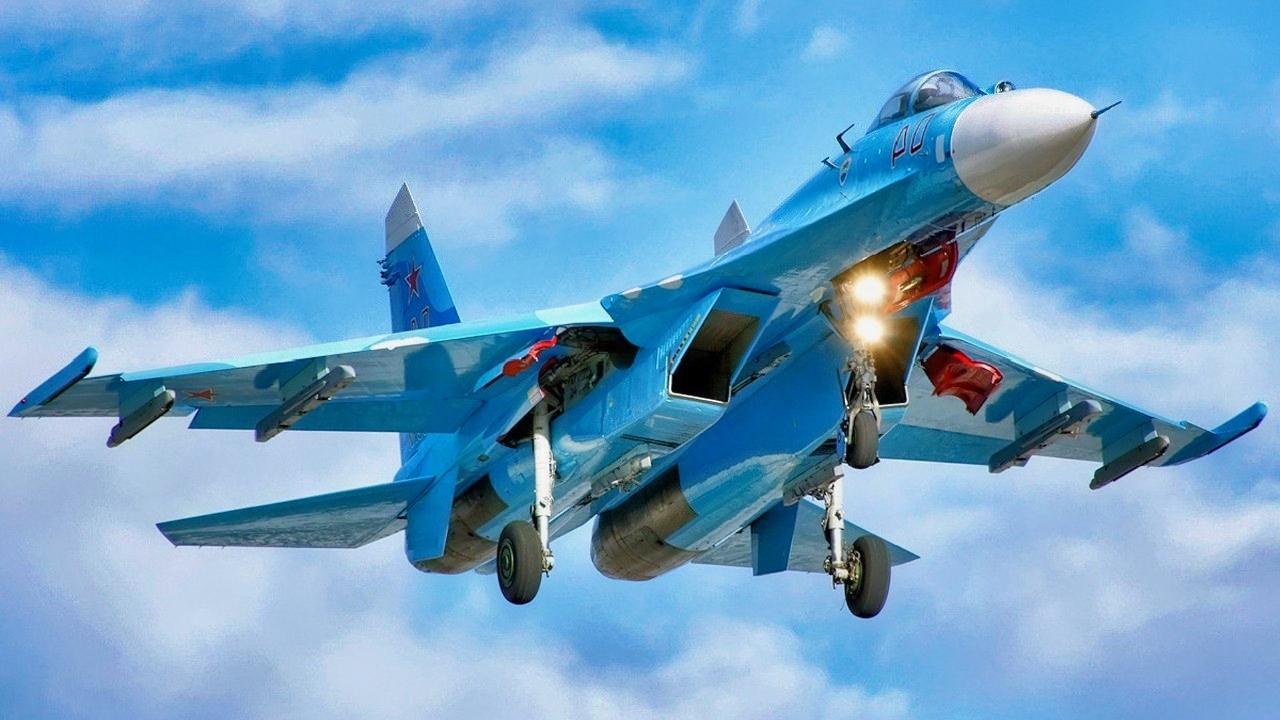Key Points and Summary – Born to counter the F-15, Russia’s Su-27 became the template for a family of agile, long-range fighters—and it still flies despite sanctions.
-Ukraine now mates Western decoys like the ADM-160 MALD to its Su-27s, while Oryx counts far heavier Ukrainian Flanker losses than Russia’s.

Su-27 Flanker Up Close. Image Credit: National Security Journal Taken on July 19, 2025.

Russian Su-27 Flanker from USAF Museum. Image Credit: National Security Journal.

Su-27 Flanker Fighter from Russia. Image Credit: National Security Journal.

Su-27 Flanker from U.S. Air Force Museum. Image Credit: National Security Journal.
-China, once the buyer and copier with its J-11, is now the lifeline: RUSI’s Jack Watling notes Russia depends on Chinese components and processes as export prospects fade.
-Beijing’s own J-20 now outclasses Russia’s Su-57.
-The role reversal raises a blunt question: how long can Moscow sustain the Su-27 amid sanctions and shrinking industrial depth today?
-BONUS: All interior photos in this article came from a photo shoot National Security Journal held at the U.S. Air Force Museum back in July 2025.
The Su-27 Flanker Fighter Questions
The Sukhoi Su-27 was developed for the Soviet Air Forces in the 1970s as a direct challenger to the United States Air Force’s F-15 Eagle, a twin-engine, high-performance, and long-range strike fighter.
Cognizant that their own MiG-23 and MiG-25 aircraft were outclassed by the F-15, particularly the American jet’s maneuverability and range, but also in particular by its powerful radar, used in combination with increasingly long-range air-to-air weaponry.
Given the vast borders of the Soviet Union, Sukhoi sought to counter American and NATO air power, ensuring that the Soviet Air Forces could defend large operational areas.
To that end, engineers at Sukhoi designed a long-range, highly maneuverable air superiority fighter to provide cover for long-range Soviet bombers, engage enemy aircraft at short and long ranges, and all on a platform that could at least match, if not exceed, the F-15 Eagle’s performance.
One of the key aspects of the jet that evolved into the Su-27 was a large internal fuel store, which provided it with the range it needed for patrol and interception.
The Su-27 is also highly agile and an excellent dogfighter thanks to its advanced aerodynamics, which give the jet maneuverability on par with the F-15.
When the Su-27 entered service in the 1980s, it was regarded as one of the most capable fighter jets in the Soviet Union, if not the world.
Alongside the comparatively lightweight MiG-29, the Su-27 mirrored the American high-low fighter mix of F-15s and F-16s, serving as a master template for other aircraft, including the Su-30, Su-33, and Su-35 derivatives.
In Ukrainian Hands
Recent footage released by the Ukrainian Air Force shed a bit of light on how the embattled country is mating Western-supplied munitions to its Soviet-designed, Cold War-era aircraft.
In the short video shared by the UAF, an ADM-160 Miniature Air Launched Decoy can be seen attached to the underwing pylon of a Ukrainian Su-27 Flanker fighter.
The ADM-160 Miniature Air Launched Decoy—MALD for short—does not carry an explosive warhead and is not used to strike targets. Instead, the small munition simulates the electronic signatures and flight profiles of various platforms.
It is intended to deceive or otherwise trick air defenses, giving cruise missiles and other munitions, also in flight, a better chance of hitting their targets.
Oryx, an open-source tracking website that tabulates equipment losses on both the Russian and Ukrainian sides, also lists Su-27 losses, with Russia’s visually confirmed Su-27 losses at three and Ukraine’s Su-27 losses at 22.
Often Imitated, Rarely Replicated
China has produced license-built copies of the Sukhoi jet, domestically dubbed the Shenyang J-11. Although initially considered a low-performance variant of the Su-27—it was based on a throttled-back export version of the jet, not intended for domestic Russian use—the platform experienced difficulties in developing a sufficiently powerful Chinese jet engine for it. Later in the 2010s, China’s engineers built a reasonably powerful engine for their Su-27 derivative jet.
Sukhoi’s Export Prospects: Dim and Fading
Russia’s export of weapons, broadly speaking, and of aerospace platforms, more specifically, has historically enjoyed several advantages over its Western counterparts. The price per unit of Russian aircraft has tended to be lower than that of Western aircraft, and their serviceability has also trended toward greater simplicity. Combined with Russia’s historic willingness to secure sales irrespective of the kinds of outside considerations like human rights records that affect Western deals, Russia’s export position before the full-scale invasion of Ukraine seemed quite secure.
But the crimping effect sanctions have played on Russia’s aerospace sector is hard to ignore, particularly on Sukhoi, one of Russia’s premier aerospace firms. Sanctions and the subsequent dearth of vital components that cannot be domestically sourced have dampened combat aircraft export prospects—but it has also been a boon to the Chinese aerospace sector, too. A recent report by Jack Watling of the Royal United Services Institute, a London-based think tank, explains why.
Until very recently, China was almost entirely dependent on first the Soviet Union and later the Russian Federation to meet its aerospace needs. “Back in the 1990s, the People’s Liberation Army Air Force (PLAAF) procured Russian aircraft, including at least three batches of Su-30MKK delivered between 1999 and 2003,” Watling writes.
“This was in addition to up to 72 Su-27 the PLAAF already had in service. Even in the 2010s, the Chinese were still eager to obtain Russian engines, since they were struggling to refine their own aircraft engines domestically,” he added.
But today that script has been flipped: China is no longer at the mercy of aerospace chairmen in Moscow. Instead, Russia’s domestic aerospace champions are reliant on the Chinese to meet their specific combat aircraft production requirements.
“Russia is now dependent on China for both components and certain treatment processes for its aircraft production. China, on the other hand, having initially started with licensed production of Russian aircraft, transitioned to unlicensed reverse engineering of Russian aircraft and is now designing and producing domestic aircraft that outperform their Russian counterparts in terms of performance. The Chinese J-20, for instance, is significantly more capable than the Russian Su-57.”
Su-27: What Happens Now?
Sukhoi’s Su-27 was conceived as a counterweight to the increasingly capable fighter aircraft in American hangars, and to prevent those jets, as well as long-range bomber aircraft, from penetrating Soviet airspace with impunity.
In that sense, the jet largely succeeded, despite the rapid collapse of the Soviet Union and the end of Cold War tensions.
But how much longer Russia can sustain the aging platform, given the detrimental effect of Western sanctions, remains to be seen.
About the Author: Caleb Larson
Caleb Larson is an American multiformat journalist based in Berlin, Germany. His work covers the intersection of conflict and society, focusing on American foreign policy and European security. He has reported from Germany, Russia, and the United States. Most recently, he covered the war in Ukraine, reporting extensively on the war’s shifting battle lines from Donbas and writing on the war’s civilian and humanitarian toll. Previously, he worked as a Defense Reporter for POLITICO Europe. You can follow his latest work on X.
More Military
The ‘Super’ B-52H Stratofortress Bomber Is Already Flying
‘Go Home’: Stealth F-22 Raptor Flew Right Under Iranian F-4 Phantom Undetected
Russia’s ‘New’ PAK DA Stealth Bomber Has a Message for Every Military On Earth
China’s New H-20 Stealth Bomber Has a Message for Any Military on Earth
Mach 2 F-4 Phantom II Fighter Has a Message for Every Air Force on Earth
